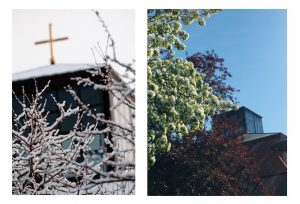This week, we hear from Mason Mennenga, an Innovation Coach at the Riverside Innovation Hub. Mason shares his understanding of the Public Church Framework and how this approach changes the way faith communities experience their own community and the local neighborhood.
“A religious experience is not simply another experience, but rather a reconfiguration of the way in which one experiences.” — Peter Rollins
Public Church1 is not another program, ministry, or outreach in which we hope for churches to add to their already-too-long list of programs, ministries, and outreaches. For far too long, churches have resorted to adding a food pantry, a sexy new Instagram account, or the latest curriculum to their Sunday school programming to engender upon people the need to have a religious experience within their walls. However, perhaps — and just bear with me — it is churches who need a religious experience: to be born again. It is the telos of Public Church to do just that — to reconfigure the way in which a church experiences its own congregation and local community. A church oriented to encountering their neighbor might just discover places of mutual transformation–places, people, and experiences that breath new life into itself and its adjacent communities alike.
Steph, a congregant and Innovation team member from one of the churches I coach through the Public Church Framework, recently had what one may describe as a religious experience. This church had a month-long adult and youth class leading participants through conversations reflecting on why they are Christian and why they participate in church. At the first session of this class, Steph and I were at a small table with other congregants. During a discussion around the table, several of these congregants voiced concerns about the number of young adults leaving the Church. While our tablemates’ anxieties were undeniably real, it seemed to Steph and I that there is more to the cultural trend of young adults leaving the Church than met our tablemates’ eyes. Nonetheless, Steph and I remained quiet and simply listened to them. After the session, Steph approached me and told me that if it was not for what she was learning by participating in the Public Church Framework, she would have perfunctorily went along with what our tablemates were saying. Without a doubt, many other people would do the same.
Accompaniment, the first part of the Public Church Framework, invites people to listen to the neighbor. In this case, Steph and her church’s innovation team listened to young adults. Steph spent time listening to her young adult coworkers and read resources on the engagement of young adults with the Church. She even picked up a copy of Phyllis Tickle’s The Age of the Spirit to learn more about the theological changes in our culture. All of this work of accompaniment was focused on listening to her neighbors and seeking further understanding of the cultural milieu in which her neighbors live.

Because of her work with the Public Church framework — listening with young adults and learning about the rapidly changing culture in which they live — Steph gained the lens to better understand the complexity of young people leaving organized religion and more faithful responses to such a shift. Her experiences of accompaniment, provided Steph with a lens that opened her up to a religious experience that did not resort to a better catechesis or a catchy new program but a wholly new way in which she experienced young people and their reasons for engaging, or not engaging, with the Church. Steph and the rest of her church’s innovation team have learned the shift of young adults leaving the church is complex, such as different ways young adults relate to religious affiliation and problematic theologies that are no longer relevant. They are also recognizing that young adults, like most everyone, prefer to be encountered uniquely as a person and not as a demographic label or a problem to be solved.
In the Christian tradition, we have a name for such a religious experience: born again. To be born again was never intended to be a switching of one’s experience from one or no religious tradition to another another but a conversion of how one experiences the world. Public Church, penultimately, attempts to provide a framework for churches to be a born-again in the way they experience their own congregation and local community. Therefore, allow your church to be born again through the learning framework of Public Church — not to lead your church into another program, ministry, or outreach but to fracture the way in which your church experiences your own congregation and local community. It begins with listening, one neighbor at a time. It continues through leaning into the curiosities that emerge, being willing to set aside old assumptions, and allowing God to invite new life that can mutually transform church and its surrounding communities alike.
1 Public Church is not another program, ministry, or outreach, but rather simply a framework by which churches can cultivate a reconfiguration of culture within their congregations to be more attentive and more faithfully responsive to their local communities.
